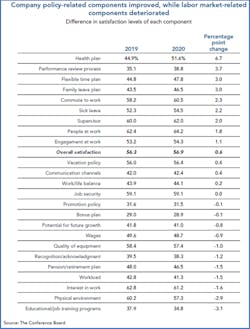Despite the fallout from the pandemic -- an economic crisis, mass layoffs, and high unemployment -- the percent of employees reporting overall satisfaction with their jobs remained high in 2020, according to a new survey from The Conference Board released on April 26.
While some components of job satisfaction declined due to the recession and economic stress, companies devoted more efforts and resources toward supporting their employees, their well-being, and their families during the pandemic. This resulted in a surprising, albeit slight, increase in job satisfaction from 56.3% in 2019 to 56.9% in 2020.
Job satisfaction did however vary by age group: Those under 35 experienced a drop in satisfaction, while those 55+ experienced an increase. In addition, the percent of workers reporting engagement in their work increased from 53.2% in 2019 to 54.3% in 2020, indicating a heightened connection between employees and their jobs. Remarkably, the results show that the job satisfaction of those working remotely was not significantly different from the satisfaction level of other workers.
The Conference Board Job Satisfaction Survey asked over 1,000 US workers about the extent to which they are satisfied or content with their overall job and its components, such as the work environment and benefits. Additional findings include:
Why didn’t job satisfaction decrease? There are two key reasons:
- The management factors: During the pandemic, many companies went above and beyond in supporting their workers.
- Respondents gave higher marks this year to many factors within the company’s control:
- Health plan: up 6.7 points
- Performance review process: up 3.7 points
- Flexible time plan: up 3.0 points
- Family leave plan: up 3.0 points
“The compassion, flexibility, and support shown by companies in 2020 played a large role in this increased job satisfaction,” said Amy Lui Abel, PhD, vice president, Human Capital at The Conference Board. “As the pandemic subsides and the residual impact on employee mental health and wellness becomes clear, companies will need to continue this support if they hope to maintain this upward trend.”
- Surprising economic factors: One might think that high unemployment would decrease job satisfaction, as happened during the Great Recession. This was not the case, however, during the pandemic.
- Workers on the sidelines had good reasons for not seeking employment: Many workers who either lost or left their jobs weren’t eager to return to work, making the job market tighter than the high unemployment rate would suggest. They were nervous about returning to the workplace because of COVID, hoped to be rehired to their previous positions, or they simply couldn’t return because they were weighed down with more childcare responsibilities.
- Layoffs soon returned to historic lows: Layoffs peaked in the spring but dropped back to historic lows by mid-summer, leaving workers feeling secure with their jobs.
- Job-hopping continued: Strong hiring, coupled with fewer job seekers per opening, resulted in quit rates bouncing back to historic highs. Even in this pandemic, many workers were voluntarily moving to new jobs.
- Not all good news: As is common during recessions, some labor market-related determinants of job satisfaction declined (i.e., wages, bonus, retirement/pension plans, potential for future growth, and spending on training).
Remote workers were not significantly more satisfied with their jobs. Age impacted job satisfaction: Older workers actually grew happier during the pandemic - but not younger workers.
- A mixed bag: While some respondents may have appreciated the increased flexibility and the elimination of a daily commute, others may have suffered from the lack of in-person interaction and perhaps a less-than-ideal working environment at home.
Age impacted job satisfaction: Older workers actually grew happier during the pandemic - but not younger workers.
- Age matters: Those under 35 experienced a drop in satisfaction, while those 55+ experienced an increase.
- Better benefits: Older workers are likely to benefit more from the additional resources offered by companies during the pandemic; they are generally more at risk for COVID-19, making health coverage a key benefit.
- Experience required: Younger workers typically suffer more during recessions as their relative lack of experience puts them at a disadvantage compared with more experienced workers, at a time when weak labor market conditions allow companies to be more selective in their job requirements.
- Younger workers hit harder: In this recession, young workers were overrepresented in some of the hardest-hit industries, such as restaurants and out-of-the-home entertainment.
Job satisfaction increased for the 10th year in a row.
- Satisfaction climbed from its lowest rate of 42.6% in 2010 to its highest of 56.7%.
- 2020 saw the highest recorded job satisfaction in 20 years.
Job satisfaction is forecast to continue improving post-pandemic.
- Reduction in unemployment: The weak growth in labor supply and the strong growth in demand for workers will likely lower the unemployment rate.
- Reduced stress: As the pandemic and childcare crisis die down, job satisfaction will likely continue to increase.
- The shift to professional jobs: In recent decades, the share of management and professional occupations in total employment has been rapidly growing. Workers in these occupations experience higher job satisfaction. This shift from manual services and routine office jobs is expected to continue.
- Shareholder to stakeholder: Increased attention on workers and human capital management, as well as the trend of making workers a more important stakeholder by boards and senior management, is likely to persist beyond the pandemic, supporting job satisfaction.
“In 2021, and in the following years, we expect Job Satisfaction to continue to improve because of a significant recovery in economic conditions,” said Gad Levanon, vice president, Labor Markets at The Conference Board. “Weak growth in labor supply and a strong demand for workers will continue to lower the unemployment rate. In fact, we predict unemployment will be at almost four percent by year’s end, barring a reversal in the pandemic trajectory.”
About the Author
EHS Today Staff
EHS Today's editorial staff includes:
Dave Blanchard, Editor-in-Chief: During his career Dave has led the editorial management of many of Endeavor Business Media's best-known brands, including IndustryWeek, EHS Today, Material Handling & Logistics, Logistics Today, Supply Chain Technology News, and Business Finance. In addition, he serves as senior content director of the annual Safety Leadership Conference. With over 30 years of B2B media experience, Dave literally wrote the book on supply chain management, Supply Chain Management Best Practices (John Wiley & Sons, 2021), which has been translated into several languages and is currently in its third edition. He is a frequent speaker and moderator at major trade shows and conferences, and has won numerous awards for writing and editing. He is a voting member of the jury of the Logistics Hall of Fame, and is a graduate of Northern Illinois University.
Adrienne Selko, Senior Editor: In addition to her roles with EHS Today and the Safety Leadership Conference, Adrienne is also a senior editor at IndustryWeek and has written about many topics, with her current focus on workforce development strategies. She is also a senior editor at Material Handling & Logistics. Previously she was in corporate communications at a medical manufacturing company as well as a large regional bank. She is the author of Do I Have to Wear Garlic Around My Neck?, which made the Cleveland Plain Dealer's best sellers list.
Nicole Stempak, Managing Editor: Nicole Stempak is managing editor of EHS Today and conference content manager of the Safety Leadership Conference.

